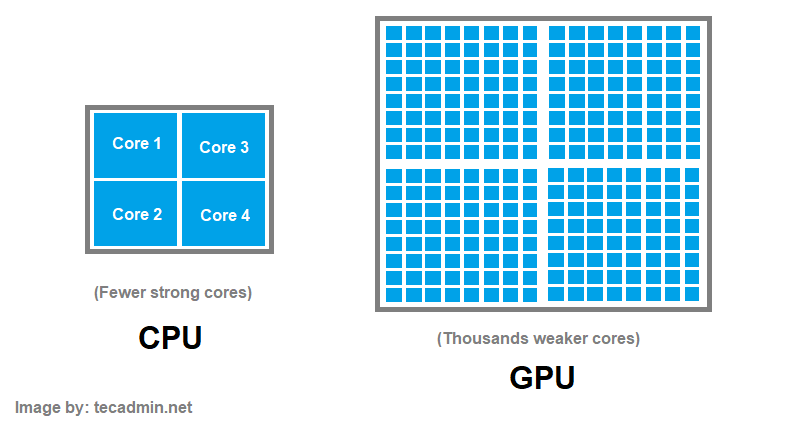In the ever-evolving landscape of computing technology, two critical components play pivotal roles in the functioning of our devices: the Central Processing Unit (CPU) and the Graphics Processing Unit (GPU). While they may seem similar at a glance, serving as the brains behind our computational devices, their roles, architectures, and efficiencies differ vastly. This article delves into these differences, shedding light on how each processor type specializes in its tasks, influencing everything from your daily computing tasks to advanced scientific simulations.

The Central Processing Unit (CPU): The Generalist
The CPU is often referred to as the “brain” of the computer, a title well-earned through its versatility and general-purpose design. It handles a wide array of tasks, from basic arithmetic to complex decision-making processes required by software applications. CPUs are designed to handle a few threads of computation at high speeds, optimized for sequential serial processing. This means they can execute tasks incredibly quickly but are limited in the number of tasks they can handle simultaneously.
CPU Architecture and Functionality
- Core Structure: CPUs have a limited number of powerful cores, usually ranging from 2 to 32+ in modern processors.
- Clock Speed: High clock speeds enable rapid sequential task processing, making CPUs efficient for complex operations.
- Cache Memory: Equipped with significant cache memory to quickly access frequently used data and instructions.
- Control Unit: Manages the execution of instructions in the CPU’s pipeline, directing operations to the appropriate hardware components.
- ALU (Arithmetic Logic Unit): Performs mathematical, logical, and decision operations, crucial for computation tasks.
- Instruction Set: Supports a wide range of commands, allowing for the execution of a vast array of tasks.
- Power Efficiency: Optimized for tasks that require high computational power per core, though power consumption varies with workload.
The Graphics Processing Unit (GPU): The Specialist
Originally designed to accelerate the rendering of 3D graphics and visual effects, GPUs have evolved to become highly efficient at parallel processing. This capability makes them exceptionally good at handling tasks that can be divided into smaller operations and performed simultaneously, such as video rendering, simulations, and particularly, machine learning algorithms.
GPU Architecture and Functionality
- Core Structure: Comprises hundreds to thousands of smaller cores, designed for parallel processing of simpler tasks.
- Clock Speed: Generally lower than CPUs, as the focus is on parallel execution of tasks rather than speed per task.
- Memory Bandwidth: High memory bandwidth to efficiently handle large volumes of data simultaneously, crucial for graphics and simulations.
- Parallel Processing Units: Specialized units for texture mapping and 3D rendering, enabling efficient graphics computations.
- CUDA Cores/Stream Processors: In NVIDIA/AMD GPUs, these cores enable parallel computing for tasks beyond graphics, like scientific computations.
- Instruction Set: More specialized than CPUs, with a focus on graphics rendering and parallel computations.
- Power Consumption: While individual cores consume less power, total power usage can be high during intensive parallel processing tasks.
Key Differences Unpacked
- Task Handling
- CPU : Optimized for sequential processing, handling a few complex tasks rapidly.
- GPU: Designed for parallel processing, managing many tasks by dividing them into smaller operations.
- Architecture
- CPU : Fewer cores, but each is much more powerful and capable of complex processing.
- GPU: Hundreds or thousands of smaller cores, designed for simplicity and parallel execution.
- Application
- CPU : Ideal for tasks requiring complex computations and logic, such as running applications and operating systems.
- GPU: Best suited for graphics rendering and computations that can be parallelized, like machine learning and video processing.
- Efficiency and Performance
- CPU : Excelling in quick data processing and execution of sequential tasks.
- GPU: Superior in handling multiple tasks simultaneously, significantly reducing time for parallelizable processes.
- Power Consumption
- CPU : Typically consumes more power per core due to its complex and high-speed operations. However, the overall power consumption depends on the workload, with CPUs being more efficient for tasks requiring quick, sequential processing.
- GPU: While GPUs consist of many smaller, less powerful cores, their design for parallel processing can lead to higher total power consumption, especially under heavy loads like 3D rendering or complex computations. However, for tasks that can be parallelized, GPUs can offer more computational power per watt than CPUs, making them more energy-efficient for specific applications.
The Complementary Duo
In the modern digital age, the distinction between CPU and GPU functionalities highlights the importance of selecting the right tool for the right job. While CPUs handle the broad spectrum of computing tasks essential for running applications and operating systems, GPUs excel in specific areas that require massive parallelism.
The synergy between CPUs and GPUs is crucial for achieving optimal performance in computers and other electronic devices. For example, in a gaming PC, the CPU manages the game mechanics and user inputs, while the GPU takes on the heavy lifting of rendering graphics, ensuring smooth and immersive gameplay.
Conclusion
Understanding the core differences between CPUs and GPUs is essential for anyone interested in the inner workings of computers, whether you’re a gamer, a professional in fields like video editing or graphic design, or just a tech enthusiast. As technology advances, the roles and capabilities of CPUs and GPUs continue to evolve, driving innovation in computing power and efficiency. Recognizing the strengths and applications of each processor type not only enlightens us about our current technology but also hints at the future directions of computing innovation.